LET'S SEE WHAT OUR ARCHAEOLOGISTS CALL A "DEFENSIVE
TRENCH" ON ONE OF THE AUCKLAND HILLS
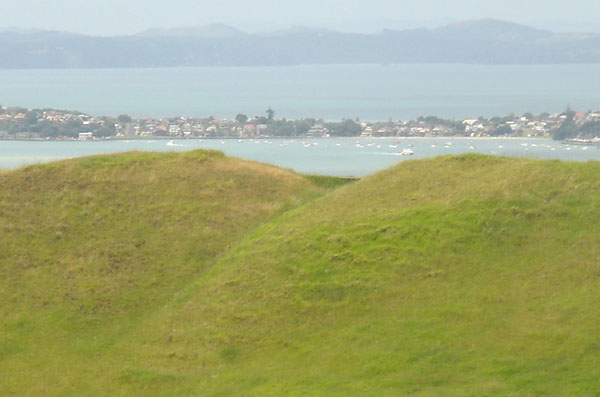
This is an ancient trench directly through the top of the
Mt. Wellington volcanic cone crest. Although officially referred to as a "defensive
trench", for curtailing the attack of invaders, it is absolutely impossible
that it could ever have worked effectively in any such role. Let's consider its
attributes:
- The trench is really quite small in terms of
its actual width and depth. Although a foot bridge has been placed within the
trench to assist people walking around the summit crest, a five year old child
could jump over the trench proper. It has no attributes akin to any known defensive
trench at a true fortress.
- The trench faces the wrong way and
would simply provide a corridor into the inner cone area where the defenders are,
hypothetically, supposed to be ensconced to ward off attacks.
- For
the trench to function in some defensive capacity, all parties would be required
to play by pre-set rules. Perhaps the defenders would have set up sign-posts,
suggesting, 'attackers, please approach from this direction' and 'defenders,
please stand and do battle here'. Any attacker not using the crest pathway,
but walking around the defensive trench, could be labelled a "dirty rotten
cheat" and subsequently disqualified, then kicked out of the battle by
the referee. As ludicrous and silly as this sounds, it's the only way this trench
could work in any defensive capacity.
The suggestion by our archaeologists
that this excavation somehow functioned as a "defensive trench"
is but a small example of the kind of codswallop they continue to force-feed us
and expect a compliant, gullible public to digest without complaint. So let's
see what the crest trench was actually made for, at exactly that position within
the vast area of the Mt. Wellington crest:
THE EQUINOX
ALIGNMENT THROUGH THE AUCKLAND ISTHMUS
Some years ago Auckland
historian and author, Andrew Adams of Howick suburb found a very significant engineer's
report tucked between pages of an old volume at Howick Public Library. It would
appear that another researcher, studying the history of the British redoubt fort
atop Stockade Hill, had left an original British Engineer's Corp. report in the
book. Andrew was surprised and delighted to find and read the report, written
in the mid-nineteenth century. It gave an account of how the British engineers
were obliged to remove standing stones from the crown of Stockade Hill in order
to dig the steep defensive trenches and form the embankments of the redoubt. Andrew
alerted the librarian about the precious papers left in the book and suggested
that they needed to be placed into the security of the National Archives for continued
public availability.
Some years later I accompanied Andrew
to the spot on Stockade Hill where the marker stones had been found 150-years
earlier and where the remains of the old British redoubt still exists. As I looked
towards Mt. Wellington, five mile to the west of Stockade Hill, I was struck by
the vivid manner in which the crest trench was so conspicuously in evidence. I
later tested the alignment, using my theodolite and theorised that the crest trench
had probably marked the equinoctial setting sun, observable from the marker stones
atop Stockade Hill. This theory was tested at the next equinox and proved to be
absolutely valid.

Left:
Mt. Wellington, an extinct volcano situated 5-miles west of Stockade Hill in Howick,
from whence this photo was taken. The crest trench is highly visible and represents
a vivid and conspicuous alignment marker from the position of the former standing
stones atop Stockade Hill.
Right: A photo taken from
the trench in Mt. Wellington's crest and, again looking towards the west. The
high hill dominating the skyline is Mt. Albert, on top of which an original, ancient
stone marker still stands beside the modern day trig.
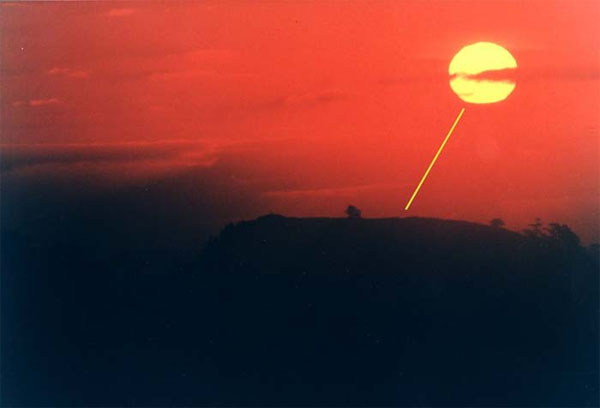
From
the observation position, once marked by standing stones, atop Stockade Hill the
sun is seen to descend towards the Mt. Wellington crest trench on the day of the
equinox.
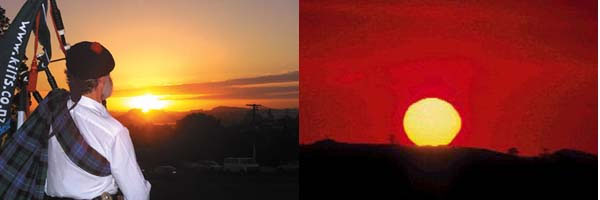
From
the Stockade Hill observation position at the dates of the vernal and autumn equinoxes
and no other days during the year, the bottom of the setting sun orb will be seen
to touch the Mt. Wellington crest trench before slipping diagonally to the left
and disappearing into the mountain. In the year 2002 we decided to formally reopen
recognition of this dynamic, ancient equinox alignment and pay homage to its Patu-paiarehe
builders, who were in New Zealand for thousands of years before the coming of
the Maori warriors. Hamilton piper, Bryan Mitchell, piped the sun on its journey
down to nestle into the Mt. Wellington trench and re-illuminate the former volcano
in fiery splendour.
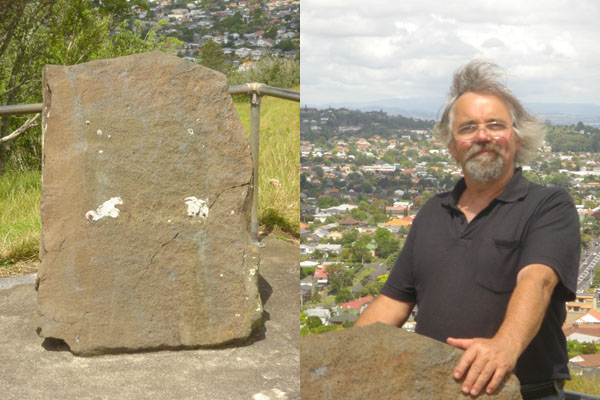
Right:
This stone has, apparently, been recorded to be atop Mt. Albert throughout the
entirety of the colonial era spanning the last 200-years. In more recent decades
concrete was poured around its sitting position and a modern trig erected nearby.
Unfortunately, a brass plaque, attached some years ago to the stone, has been
stolen recently, cracking the ancient marker in the process of its brutal and
violent removal.
Left: The author stands by
the large stone with some of the high Auckland isthmus hills or distant mountains
seen in the background. The panoramic vista through 360-degrees includes Mt Wellington,
with its crest trench conspicuously in full view.
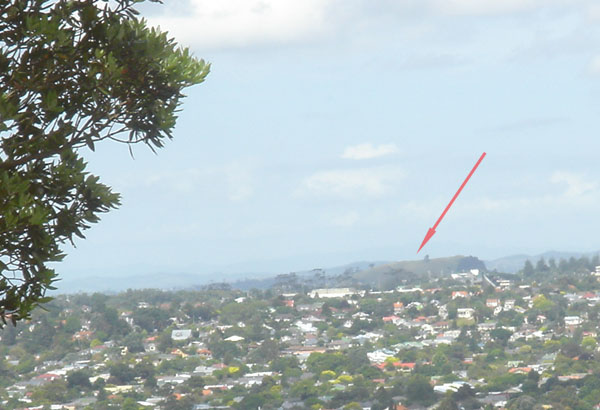
The
selfsame crest trench on Mt. Wellington, which is viewable from Stockade hill
in Howick suburb, is also easily seen from the marker stone position atop Mt.
Albert. On the mornings of the vernal or autumn equinoxes the sun is seen to rise
from Mt. Wellington's crest trench position. The distant Coromandel Ranges sit
just slightly higher than the crest trench when one is standing fully erect atop
Mt. Albert, but the trench represents the position of "first glint"
of the sun on the equinox days. Ancient calendars could, accordingly, be kept
fully accurate with ease by that reliable, reoccurring biannual solar event. A
Titirangi based professional surveyor, Mr Surman, has tested the 11.5-mile (18.5
kilometres) long alignment with state-of-the-art equipment and concluded that
the degree of offline error over that distance is less than 1-second of arc...
less than 100 feet. The Mt. Albert to Mt. Wellington segment of the Auckland Isthmus
equinox alignment was first noticed by a former colleague, over 25-years ago.
He, unfortunately, has chosen to not make the greater New Zealand public privy
to this information, by providing a printed or Internet publication.
SO,
HOW DOES MT. WELLINGTON LINK UP WITH THE TRIGS ON THE BOMBAY HILLS?
A
Maori name for Mt. Wellington is Maungarei, which means "the watchful
mountain". Many of these New Zealand Maori names were derived from the
earlier Patu-paiarehe people, who taught Maori a wide variety of arts, including
those of moko (facial tattooing) and haka (dance). The "watchful mountain"
title, handed down in oral tradition, is certainly very descriptive of Mt.
Wellington, which is centrally positioned to act as a hub for alignments within
the Auckland Isthmus or a distribution and reference point for surveying alignments
to far-flung locations like the Bombay Hill region. The ultimate and most conspicuous
target from Mt. Wellington southward was across Bombay Hill to the highest point
of Mt. William (Puketutu) 23-miles (37-kilometres) distant. Alternatively,
the southward alignment from Stockade Hill in Howick crossed Pukekiwiriki
Hill to resolve upon He Tohu Kairuri (B2D4) Hill in the Mt. William
complex. From Mt. Albert's summit stone marker the southward alignment ran to
the tor mound atop Bombay Hill then onward to the pointed top of He Tohu
Kairuri (B2D4) Hill.
As one approaches Mt. Wellington
from the south, its modern day trig is centrally conspicuous. It's also easy to
detect that the modern trig sits atop an ancient mound pimple, which constituted
the purpose built position of the original Patu-paiarehe trig from, conceivably,
thousands of years ago.
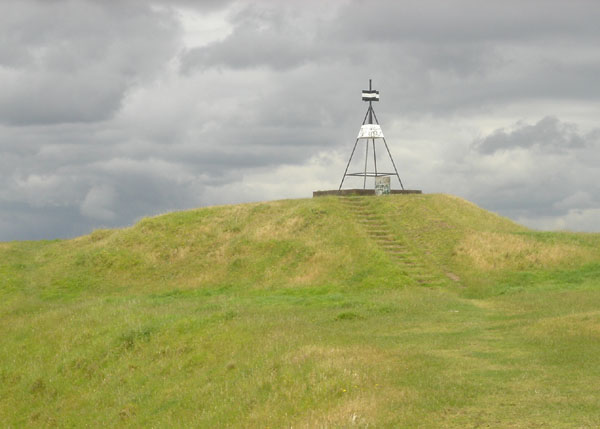
The
modern trig tower on Mt. Wellington, sitting atop an ancient mound that was purpose
built to serve the same purpose thousands of years ago.
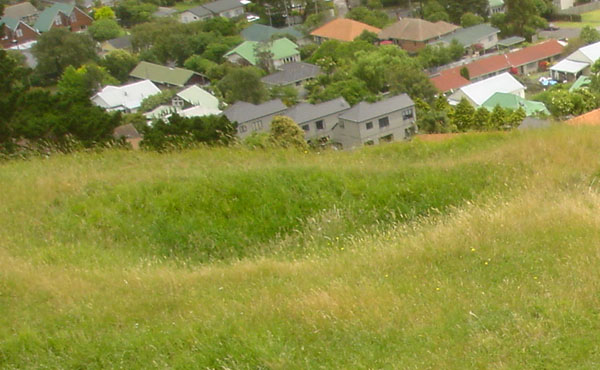
One
of the many "sighting pits" used by the ancient Patu-paiarehe people
for surveying and overland alignments. These carefully placed observation positions
circumnavigate the rim of the extinct volcano and align onto similar "sighting
pits" or stone markers on the other Auckland hills. The surveying attributes
of each one can be identified with careful and precise work, using a handheld
GPS unit for coordinate fixes and a computer for analysing results. One would
need to visit the many hills of the Auckland Isthmus where the sighting pits or
other markers survive in profusion and record all of the positions accurately.
After that, it is only the tedious activity of "joining the dots" to
test the angle codes or surveying attributes contained in the alignments hill
to hill.
Modern-day archaeologists call these depressions
"kumara pits" and tell us they were built for storing the "sweet
potato". As outlandish and unorthodox as it might seem, maybe, just maybe,
they could apply something called the "scientific approach" and test
the merits of these depressions as possible surveying trigs... they might get
a very big surprise.
Supplimentary
quotes relating to the carved, stone-walled and much modified Auckland Hills and
their earliest inhabitants:
'There are several very singular
hills rising boldly from the surrounding land [Auckland], in shape and
form closely resembling the Roman encampments on the Tumuli that abound in many
parts of England & having like them three or four distinct fops or ditches
encircling them towards the summit - This singular too that these have been formed
for defence by the natives - the top of every hill is marked in this way with
distinct lines of circumvallation. An antiquary might from this circumstance deduce
a connection between the New Zealanders and the ancient
Romans!!' (see Felton Mathew's unpublished letters to his wife,
Special Collections, Auckland Public Library.
Another early explorer
noted:
'Arriving at the foot of the mountain [Mt. Eden] we assayed
its ascent in the course of which my friend evinced a deep interest in traces
of Maori fortifications of a past age, which were everywhere in evidence, the
escarpments, trenches and what had once been covered ways and store pits though
fallen in or overgrown, were yet in a wonderful state of recognition.
Several
of the stone walls of these fortifications could still be traced with considerable
accuracy, although the oldest living Maori could not tell
when, or by whom, they were erected.
The Maori race show a wonderful
aptitude for field engineering in warfare, and these traces of ancient fortifications,
in particular, have often called forth the highest commendation from those most
capable of judging such matters.
It must have taken a
much larger population than was then to be found to man these fortifications
effectively, so extensive were they, the whole mountain appearing to be girt by
them, line after line, from bottom to top (see Sketches of Early Colonisation
in New Zealand -and its Phases of Contact With the Maori Race, (circa late
1840's), by "Te Manuwiri", pg. 123, Whitcomb & Tombs).
Another
publication states:
"Maungawhau, 'the mountain of the whau',
a shrub believed to have been growing in the area. The shrub was valued for its
cork-like wood, used for floats on fishing nets...Maori legend tells of Maungawhau's
[Mt. Eden's] first inhabitants, the Patupaiarehe
or Turehu, who were skilled in the arts of fishing, hunting, weaving and
warefare. It is said that this nocturnal people were destroyed as they lingered
building a bridge after dawn"(see The Changing Face Of Mt. Eden, pg. 8,
Mt. Eden Borough Council, 1989).
Indeed, British Archaeologist, Aileen
Fox made much the same observation in her 1976 book, Prehistoric Maori Fortifications
in the North Island of New Zealand, remarking on the distinct similarities
between Maori PA's and the ancient, palisade encompassed, pre-Celtic hill forts
of Britain. A mass of such landscape evidence, incorporating many kinds of structures
across New Zealand, has been, in recent years, increasingly relegated to the realm
of politically incorrect, fringe or pseudo-science and, consequently, never allowed
to be seriously investigated by our mainstream archaeologists or historians.
Of
these extensive fortifications, built in a very European style, leading historian
Elsdon Best said:
The Maori did not live in this manner in his former
home in eastern Polynesia. Did he evolve the pa system after he settled here,
or did he borrow it from former inhabitants? (see:
The Maori As He Was - A Brief Account of Maori Life as it was in Pre-European
Days, Chapt. VI, pg. 165).
If the Polynesian Maori brought the artefacts,
symbols and motifs here, then why are they not found in their lands of origin?
Historian/ anthropologist, Edward Tregear, asked this same question. Professor
Thor Heyerdahl wrote the following on this very subject:
'Irrespective
of how and when the Maori began to cover their carvings with spirals, the
habit is absent in their Polynesian homeland and may therefore very well
be so in their still earlier fatherland further away. There is, indeed, no such
curvilinear surface design on the wood carvings of the Society Islands and these
include the very tall ancestral posts which were erected in ancient Tahiti' (see
American Indians in the Pacific, pg. 116).
One of the last surviving
sub-tribes of the Patupaiarehe or Turehu was the Ngati Hotu, pockets of whom survived
into colonial times. Here's a description of them from Maori Oral tradition:
Generally
speaking, Ngati Hotu were of medium height and of light colouring. In the majority
of cases they had reddish hair. They were referred
to as urukehu. It is said that during the early stages of their occupation of
Taupo they did not practice tattooing as later generations did, and were spoken
of as te whanau a rangi (the children of heaven) because
of their fair skin.
There were two distinct types. One had a kiri
wherowhero or reddish skin, a round face, small eyes and thick protruding
eyebrows. The other was fair-skinned, much smaller in stature, with larger and
very handsome features. The latter were the true urukehu and te whanau a rangi.
In some cases not only did they have reddish hair,
but also light coloured eyes.
(See Tuwharetoa, chapter 7, page 115,
by Rev. John Grace).
So, what was the general fate of these remnant
Patu-paiarehe or Turehu, some of whom were of mixed-Maori blood (captured slave
women) by the time Hongi Hika unleashed the "Musket Wars" on
other Maori tribes around 1818 and thereafter?
'A Maori relating an account
of an expedition said, incidentally: 'On the way I was speaking to a
red-haired girl who had just been caught out in the open. We were then
on the eastern side of Maunga Whau, Auckland. My
companions remained with the girl whilst I went to see the man of Waikato who
had been killed. As we came back, I saw the head of the red-haired
girl lying in the ferns by the side of the track. Further on, we overtook
one of the Waihou men carrying a back-load of the flesh, which he was taking to
our camp to cook for food. The arms of the girl were round his neck, whilst the
body was on his back.' If one can mentally picture the scene, with the man striding
along, carrying the headless, disembowelled trunk of the naked girl, enough of
this kind of horror will have been evoked...' (see Edward Tregear, The Maori
Race, New Zealand, 1904).
Continue